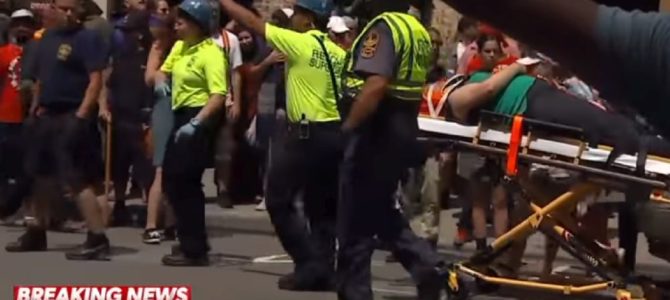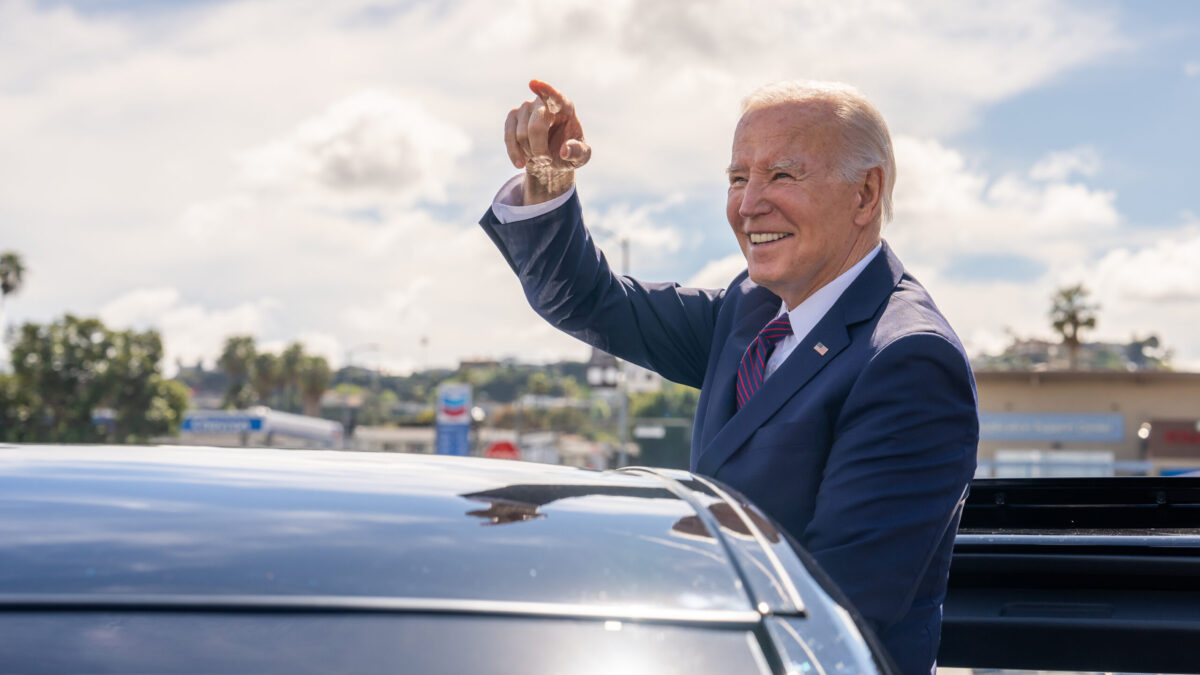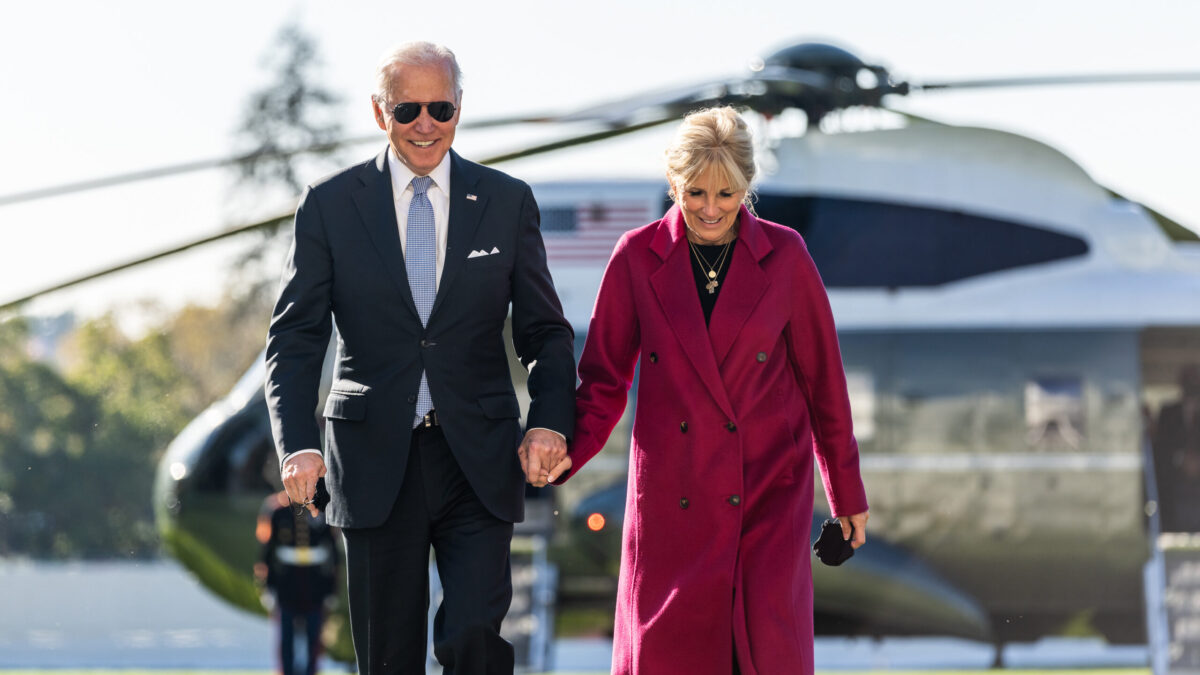
Virginia’s governor, Terry McAuliffe, just declared a state of emergency for Charlottesville after violent battles between white nationalists and far-left “antifa” counter-protesters. I made it into town Saturday evening, and it certainly did look like a place in a state of emergency, though without any sign of the emergency itself.
The streets were eerily empty for a Saturday night, both downtown and on campus, and there was a much higher than usual police presence everywhere. Even the grocery store where I stopped on the way out of town had extra security guards on staff, chatting idly with each other in a corner because they had nothing to do.
Around Lee Park, the center of the riot, most of the roads through the downtown area were blocked off, and when I turned down one side street trying to see the extent of it, I came across a group of about 40 police. They were the only people there. Downtown Charlottesville has basically been shut down. I then drove by the county office building, which is a little off to the side of downtown, and it has a very large parking lot that has been turned into a giant tent city for the police, filled with emergency vehicles. I suppose that’s what McAuliffe’s “state of emergency” is about: they’re drawing cops from surrounding communities to get enough manpower to put the town on lockdown.
The signs of the emergency itself were hard to see because it was a man-made emergency.
I knew there was going to be trouble Friday night, when Richard Spencer and his white nationalist followers returned for another tiki-torch Nuremberg . It was exactly what they had done before, a few months ago, but this time with a dangerous difference. The previous rally was at Lee Park, because that’s where the Civil War statues are that the city has decided to remove, and which Spencer seized on as his cause. But that is an area near the county courthouse, surrounded by government buildings and lawyers’ offices. There’s no retail, no restaurants, and few residences, and it’s far away from the University of Virginia campus. The area is generally empty on evenings and weekends—which is to say that it’s not a good place to provoke a riot.
This time, the white nationalists started out Friday night by marching to a statue of Thomas Jefferson that stands right outside the Rotunda, just on the other side of the Lawn—that is, in the heart of the UVA campus. This is an excellent place to provoke a riot. Friday night had a few scuffles, but after a few minutes, the police kept the Nazi types moving along. It turns out they were just lighting the fuse, baiting the hook. When they returned to Lee Park (now somewhat clumsily renamed “Emancipation Park”) on Saturday, they had a proper counter-mob of “antifa” protesters to meet them.
When I mention the white nationalists, I should note that they are not some spontaneous outpouring of local sentiment. Someone on the Left posted photos of the neo-Nazis on Twitter and asked if people could identify them, speculating that they might be members of University of Virginia College Republicans. (This person has apparently never met a college Republican. In my experience, they are paragons of bland respectability.)
When he actually got his answers, it turns out that the people in the photos were all known, active white supremacists—the usual suspects—and they came from all across the country: Arkansas, Nevada, North Dakota, Texas, Massachusetts, California. Everywhere but Charlottesville. I’m not saying that It Can’t Happen Here, but Spencer and his brownshirt wannabes are a very, very small fraction of the population. They have to draw from across the country to get enough people all in one place to be noticeable.
If Spencer’s march was deliberately designed to provoke a riot, the “antifa” college kids gave him what he wanted. So far, I’ve seen this downplayed in press coverage, but antifa came ready for fighting, too. Check out the photos here. Both sides came with their helmets and their goofy homemade shields, as if this is some kind of lame, hellish parody of a Renaissance Faire.
The two sides are mirror images of each other, and both have an interest in making our politics devolve into street fighting. Both sides have also been priming their people to be ready to kill for the cause, and it appears that Spencer’s gang got there first, with one of his followers ramming his car into a crowd and killing a young woman.
The ominous implication of this weekend’s riots is that we are letting our politics descend into a brutal, unprincipled, physical brawl between two illiberal caricatures—which drowns out real debates over opposing ideas and marginalizes any unifying principles that we might draw on as reasons not to just kill each other.
The Left has been doing this by styling themselves as revolutionaries and “the Resistance,” and by indulging its young “antifa” anarchists—Communist “anti-fascists” who behave a lot like fascists, employing rioting and street battles as their main form of political activism. On the Right, the problems are summed up in President Trump’s lame statement on Charlottesville. Claims that Trump was somehow excusing white nationalism are overblown, given that he also condemned “bigotry.” But his only answer was a series of vague bromides about national unity and loving each other—a solution he has never managed to practice and for which he cannot be a credible advocate.
Trump was elected precisely because he does not have any of the governing virtues of normal politicians, such as the ability to be gracious and inclusive to the opposition, to understand and defuse the objections of political opponents, and to make unifying gestures that unite Americans around shared values and ideas. His supporters argued that he could accomplish more by dispensing with this kind of prissy concern for civility. They did not imagine—because they didn’t really think about it—that we might find ourselves in a situation where those virtues would be not only desirable but absolutely necessary.
We are in a state of emergency, and it’s because we’re letting our political debate be defined on illiberal terms. We’re supposed to either back the guys who try to re-enact Nuremberg, or we back the guys who whip themselves up into a frenzy to “punch Nazis”—and define “Nazi” as anyone who disagrees with them. We either want technology companies to conduct ideological inquisitions, or we’ve got guys chanting “Blood and Soil.” We take a vicious murder by a racist and turn it into another opportunity to score partisan political points on social media—as if we want racism to be a partisan issue rather than a common cause that transcends party.
I wrote recently about the steps required to condition people to accept totalitarianism. One of those steps—one of the last ones—is that we get used to political differences being settled by a contest of force in the streets. We’ve been closer to that point before, during the 1960s, when the violent protests and race riots were far bigger. But that was the brink of a very deep precipice, and we should be doing everything we can, on both sides of the political debate, to pull back from it.
Follow Robert on Twitter.









